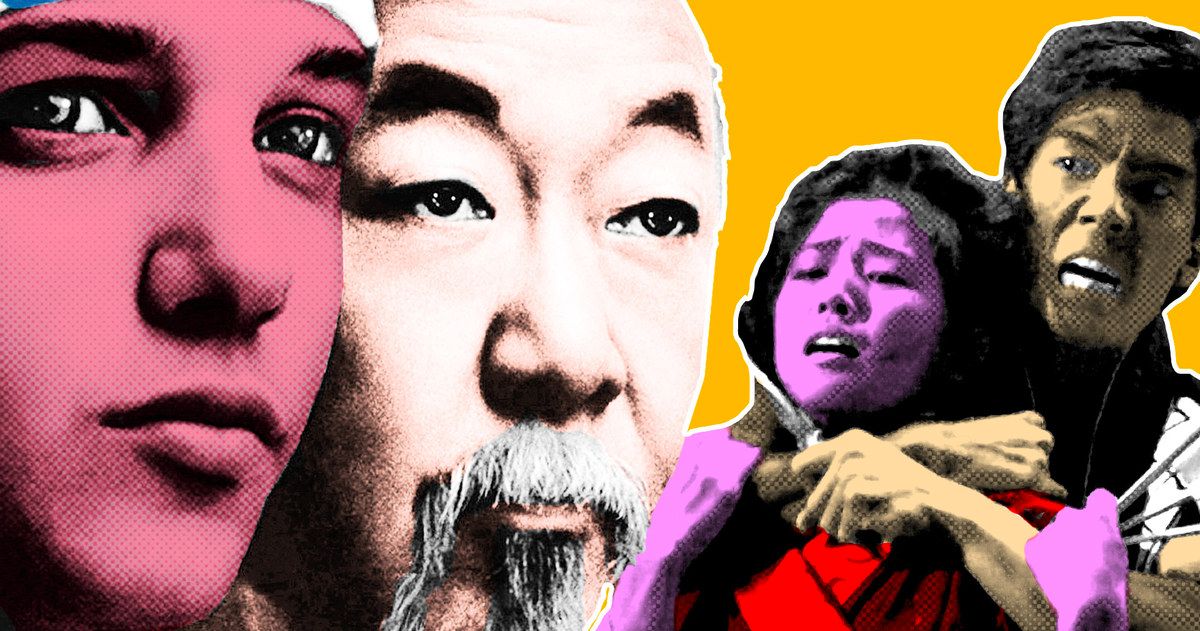This is how you make a sequel! The Karate Kid Part II took the hero and the relationship we loved from the first movie in a new environment, deepening the mythology, with heavy helpings of romance, mystery, and even higher stakes. Today, we're taking a look at 10 things you never knew about The Karate Kid Part II.
The end is the beginning.
The Karate Kid Part II picks up right where the first movie left off, in the aftermath of Daniel LaRusso's improbable victory at the All Valley Karate Championship. Mister Miyagi saves Johnny Lawrence and the Cobra Kai students from their sensei, the world's sorest loser. If this intro feels like it was sliced right out of the first movie, that's because it basically was, at least from the script. Kreese getting his comeuppance was originally intended to be the final scene of the first movie.
'Though the shower and parking lot scenes were written for The Karate Kid, they were, in fact, filmed later specifically for Part II. It works great here, particularly given the honk on the nose dished out later on, which brings things full circle.
Ali's scene was scrapped.
Most fans know that the first movie's love interest, Ali Mills, was written out of the sequel due to future Oscar nominee Elisabeth Shue's plans to head to Harvard. What's lesser known is that the producers originally planned to shoot a short scene where Ali breaks up with Daniel, but later decided to explain all of it via dialog instead.
That's not Okinawa.
Returning director John G. Avildsen and his team did some location scouting in Okinawa, home to a large U.S. military presence since World War II. Writer Robert Mark Kamen, who based The Karate Kid partly on his own life, told Sports Illustrated that he used the sequel as an excuse to visit his old teacher and do some training. But The Karate Kid Part II was filmed mostly in Hawaii. The 50th state doubled as the Japanese island chain in the East China Sea, thanks to its similar climate and large Okinawan population. Production designer Bill Cassidy supervised the construction of the sets for Miyagi's home village. (There's a 7-11 in that spot now.)
Miyagi's big adventure.
The Karate Kid Part II did some shooting in the valley, on the Warner Bros. backlot. As pointed out by writer Jared Cowan in one of his meticulously researched pieces for the LA Weekly, the façade used for the downtown Naha electronics store is the same one used as Madame Ruby's fortune-teller shop in Pee Wee's Big Adventure.
Miyagi's friends.
Nobu McCarthy, Mr. Miyagi's love interest in The Karate Kid Part II, had acted with the late Pat Morita before. She played his character's fiancé in an episode of Happy Days titled "Arnold's Wedding." In that LA Weekly article, Avildsen said Danny Kamekona, who plays Miyagi's best friend turned nemesis, was an old pal of the actor. "The used to get into mischief together." Kamekona later played an old war buddy of Higgins on an episode of Magnum PI, a character also named Sato.
8-bit slabs of ice.
The Karate Kid Part II: The Computer Game was released in 1986 for the Atari ST and Amiga. It included a digitized version of one of the movie's most iconic scenes, when Daniel breaks through slabs of ice. This scene also made it into The Karate Kid Nintendo game, which was released the following year. Stages two through four and two bonus games in the NES classic are based on The Karate Kid Part II.
A Presidential visit.
Late producer Jerry Weintraub knew George H.W. Bush, then the Vice President of the United States, and invited him to visit the set. The production built a helicopter pad at the last minute for his Black Hawk. Avildsen later said that while Bush was a very nice guy, he certainly never voted for him and his policies, in 1988 or 1992.
The Rocky connection.
Composer Bill Conti and late director John G. Avildsen made The Karate Kid and the first Rocky together. Conti stuck with the Rocky franchise for two more installments, but passed on Rocky IV in order to re-team with Avildsen for The Karate Kid Part II. (Avildsen and Conti both returned for Rocky V.) Incidentally, former Chicago singer Peter Cetera's "Glory of Love" was originally written for Rocky IV, but rejected. After it was included in The Karate Kid Part II, instead, it earned an Oscar nomination.
It was the most successful Karate Kid.
Movies like Rocky II, Back to the Future II, and Revenge of the Nerds II: Nerds in Paradise failed to perform as well as their predecessors, but The Karate Kid Part II actually did better than the first and still ranks as the most commercially successful in the series. Part II made $115.1 million domestically, which would be about $284.1 million today, according to Box Office Mojo. When adjusted for ticket price inflation, Part II is the most successful, followed by the original, the 2010 remake with Jaden Smith and Jackie Chan, The Karate Kid Part III, and box-office bomb The Next Karate Kid.
There was almost another Karate Kid Part II.
While it was far from a critical success, the 2010 remake did have a sequel in development at Sony, with The Crazies director Breck Eisner attached, 'though by 2014, he was out. There have been various scripts, including passes from writers who worked on Kung Fu Panda. Jaden Smith's character would seek revenge following the death of his mentor, played by Jackie Chan, according to an un-credited description on IMDB. Given that Will Smith and his production company, who control part of the Karate Kid rights, gave their blessing to the well-received Cobra Kai YouTube series, a sequel to the reboot seems less likely than ever.

